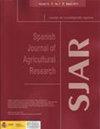牧场山羊身体状况评分、血清代谢物和矿物质浓度作为卵巢活动和妊娠成功率的指标
IF 0.8
4区 农林科学
Q3 AGRICULTURE, MULTIDISCIPLINARY
引用次数: 0
摘要
研究目的:研究交配时卵巢结构相对于血清代谢产物和矿物质浓度的潜在差异。此外,还比较了怀孕和未怀孕山羊交配时的身体状况评分(BCS)、血清代谢产物和矿物质分析。研究区域:墨西哥北部热区(26°N)。材料和方法:在非繁殖季节,对干旱牧场上的杂交山羊(n=89)进行雄鹿暴露。在交配时和繁殖后10天用超声波记录卵巢结构。在交配后30天和120天检测到妊娠。交配时测定BCS、血液代谢产物和矿物质。主要结果:妊娠山羊交配时BCS高于未妊娠山羊。怀孕山羊的平均血糖浓度高于未怀孕山羊(87.3±12.1 vs.74.4±11.6 mg/dL)(p<0.05)。交配时,未怀孕山羊的血清尿素氮水平(10.7±3.5 mg/dL)显著低于怀孕山羊(12.4±3.7 mg/dL,p<0.01)。较低的血糖(72.2±6.9 vs.89.4±11.2)和较高的非酯化脂肪酸浓度(NEFA;0.43±0.23vs.0.18±0.12)与妊娠损失显著相关(p<0.05)。血清总蛋白浓度越高,排卵卵泡数量越多,卵泡越大。高血清磷与较大的排卵卵泡显著相关。排卵卵泡≥7.6mm的山羊比排卵卵泡较小的山羊更有可能怀孕(p<0.05)。研究重点:监测BCS、血糖、血尿素氮和NEFA可用于识别有不孕风险的山羊。本文章由计算机程序翻译,如有差异,请以英文原文为准。
Body condition score and serum metabolites and minerals concentrations as indicators of ovarian activity and pregnancy success in goats on rangeland
Aim of the study: To investigate potential differences in ovarian structures relative to serum metabolite and mineral concentrations at mating. Also, body condition score (BCS), serum metabolites, and mineral profiling at mating were compared between pregnant and non-pregnant goats.
Area of study: Hot zone of northern Mexico (26 °N).
Material and methods: Mixed-breed goats (n= 89) on arid rangeland were exposed to bucks during the non-breeding season. Ovarian structures were recorded at mating and ten days after breeding using ultrasonography. Pregnancy was detected at 30 and 120 days post-mating. BCS, blood metabolites, and minerals were determined at mating.
Main results: Pregnant goats had higher BCS at mating than non-pregnant goats. The mean serum glucose concentration was higher (p<0.05) for pregnant goats than that for non-pregnant ones (87.3 ± 12.1 vs. 74.4 ± 11.6 mg/dL). Significantly lower (p<0.01) serum urea nitrogen levels at mating were recorded in non-pregnant (10.7 ± 3.5 mg/dL) than in pregnant goats (12.4 ± 3.7 mg/dL). Lower serum glucose (72.2 ± 6.9 vs. 89.4 ± 11.2) and higher non-esterified fatty acids concentrations (NEFA; 0.43 ± 0.23 vs. 0.18 ± 0.12) were significantly associated (p<0.05) with pregnancy loss. Higher serum total protein concentrations were associated with a greater number and larger ovulatory follicles. High serum phosphorus was significantly associated with larger ovulatory follicles. Goats with ovulatory follicles ≥7.6 mm were more likely (p<0.05) to get pregnant than goats with smaller ovulatory follicles.
Research highlights: Monitoring BCS, serum glucose, blood urea nitrogen, and NEFA could be used to identify goats at risk for infertility.
求助全文
通过发布文献求助,成功后即可免费获取论文全文。
去求助
来源期刊

Spanish Journal of Agricultural Research
农林科学-农业综合
CiteScore
2.00
自引率
0.00%
发文量
60
审稿时长
6 months
期刊介绍:
The Spanish Journal of Agricultural Research (SJAR) is a quarterly international journal that accepts research articles, reviews and short communications of content related to agriculture. Research articles and short communications must report original work not previously published in any language and not under consideration for publication elsewhere.
The main aim of SJAR is to publish papers that report research findings on the following topics: agricultural economics; agricultural engineering; agricultural environment and ecology; animal breeding, genetics and reproduction; animal health and welfare; animal production; plant breeding, genetics and genetic resources; plant physiology; plant production (field and horticultural crops); plant protection; soil science; and water management.
 求助内容:
求助内容: 应助结果提醒方式:
应助结果提醒方式:


